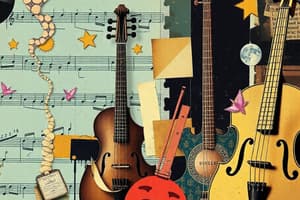Podcast
Questions and Answers
Which combination of instruments creates a snappy and punchy sound in orchestral doublings?
Which combination of instruments creates a snappy and punchy sound in orchestral doublings?
- Muted brass mixed with pizzicato strings (correct)
- Xylophone and trumpets
- Celeste and winds
- French horn and chimes
Which combination of instruments creates a somber and restrained sound in orchestral doublings?
Which combination of instruments creates a somber and restrained sound in orchestral doublings?
- English horn and muted viola (correct)
- Xylophone and trumpets
- Celeste and winds
- Pizzicato strings and woodwinds
What should be considered when creating effective orchestral doublings?
What should be considered when creating effective orchestral doublings?
- The tempo and dynamics
- The number of players assigned to each line
- The composer's personal preferences
- The choice of timbre and register (correct)
- Orchestral doublings involve assigning one line to multiple players to create unique colors in ______ music.
- Orchestral doublings involve assigning one line to multiple players to create unique colors in ______ music.
- The choice of ______ and register is crucial in creating effective orchestral doublings.
- The choice of ______ and register is crucial in creating effective orchestral doublings.
- Doublings should be used sparingly for special effects or to contrast ______ textures.
- Doublings should be used sparingly for special effects or to contrast ______ textures.
What are orchestral doublings and how do they create unique colors in orchestral music?
What are orchestral doublings and how do they create unique colors in orchestral music?
What are some of the common orchestral doublings discussed in the video?
What are some of the common orchestral doublings discussed in the video?
What advice does the composer give for using orchestral doublings effectively?
What advice does the composer give for using orchestral doublings effectively?
Flashcards are hidden until you start studying
Study Notes
Exploring Orchestral Doublings: Creating Unique Colors in Orchestral Music
- Orchestral doublings involve assigning one line to multiple players to create unique colors in orchestral music.
- The video focuses on seven common orchestral doublings that the composer frequently uses in his own music.
- The first texture discussed is muted brass mixed with pizzicato strings, which creates a snappy and punchy sound.
- Pizzicato strings can also be paired with woodwinds for a more subdued effect.
- Celeste and winds create a soft and resonant sound, commonly used in John Williams' music.
- Xylophone and trumpets create an aggressive and percussive sound, often used in action scenes.
- French horn and chimes create a powerful texture for climactic moments in music.
- English horn and muted viola create a somber and restrained sound, ideal for emotional moments in music.
- The choice of timbre and register is crucial in creating effective orchestral doublings.
- Doublings should be used sparingly for special effects or to contrast soloistic textures.
- The composer advises caution and responsibility in using these tools to create unique colors in orchestral music.
- Viewers can support the composer through likes, subscriptions, or joining his Patreon for bonus content and monthly Q&A sessions.
Exploring Orchestral Doublings: Creating Unique Colors in Orchestral Music
- Orchestral doublings involve assigning one line to multiple players to create unique colors in orchestral music.
- The video focuses on seven common orchestral doublings that the composer frequently uses in his own music.
- The first texture discussed is muted brass mixed with pizzicato strings, which creates a snappy and punchy sound.
- Pizzicato strings can also be paired with woodwinds for a more subdued effect.
- Celeste and winds create a soft and resonant sound, commonly used in John Williams' music.
- Xylophone and trumpets create an aggressive and percussive sound, often used in action scenes.
- French horn and chimes create a powerful texture for climactic moments in music.
- English horn and muted viola create a somber and restrained sound, ideal for emotional moments in music.
- The choice of timbre and register is crucial in creating effective orchestral doublings.
- Doublings should be used sparingly for special effects or to contrast soloistic textures.
- The composer advises caution and responsibility in using these tools to create unique colors in orchestral music.
- Viewers can support the composer through likes, subscriptions, or joining his Patreon for bonus content and monthly Q&A sessions.
Exploring Orchestral Doublings: Creating Unique Colors in Orchestral Music
- Orchestral doublings involve assigning one line to multiple players to create unique colors in orchestral music.
- The video focuses on seven common orchestral doublings that the composer frequently uses in his own music.
- The first texture discussed is muted brass mixed with pizzicato strings, which creates a snappy and punchy sound.
- Pizzicato strings can also be paired with woodwinds for a more subdued effect.
- Celeste and winds create a soft and resonant sound, commonly used in John Williams' music.
- Xylophone and trumpets create an aggressive and percussive sound, often used in action scenes.
- French horn and chimes create a powerful texture for climactic moments in music.
- English horn and muted viola create a somber and restrained sound, ideal for emotional moments in music.
- The choice of timbre and register is crucial in creating effective orchestral doublings.
- Doublings should be used sparingly for special effects or to contrast soloistic textures.
- The composer advises caution and responsibility in using these tools to create unique colors in orchestral music.
- Viewers can support the composer through likes, subscriptions, or joining his Patreon for bonus content and monthly Q&A sessions.
Studying That Suits You
Use AI to generate personalized quizzes and flashcards to suit your learning preferences.




